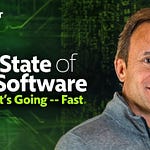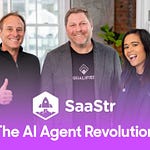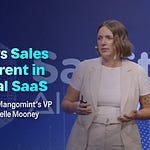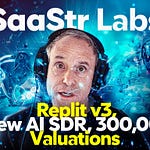How We Built ChatGPT Enterprise's Sales Team from Absolute Zero: The Complete Playbook with Maggie Hott, GTM Leadership at OpenAI
About Maggie: Maggie Hott has spent 15 years building go-to-market teams at four unicorns that collectively represent over $50B in market value. She started as the 2nd SDR at Eventbrite, became the first sales hire at Slack (helping scale from $50M to $1B ARR and a $27B Salesforce acquisition), served as Director of Sales at Webflow (scaling from $40M to $140M ARR), and now leads go-to-market at OpenAI where she built ChatGPT Enterprise from scratch. She also runs a venture fund with seven other women investors, backing 30+ founders. These are her personal views, not those of OpenAI.
It was early 2023. OpenAI had just launched ChatGPT, the fastest-growing consumer app the world had ever seen. We were riding an incredible wave, but we had a critical hypothesis: ChatGPT Enterprise would require a fundamentally different go-to-market motion than our API business.
When OpenAI hired me to build ChatGPT Enterprise from scratch, I walked into what can only be described as a beautiful blank slate—and a terrifying challenge.
Our entire sales and go-to-market organization was less than 10 people. No SDRs. No solution consultants. No customer success managers. No sales operations. No RevOps. No marketing enablement. We didn't even have a working Salesforce instance.
What we did have: six incredibly talented account directors and one technical success partner, all laser-focused on selling our API to developers and technical teams.
Here's the complete playbook for how we built what we believe became the fastest-growing enterprise application in history.
The Build vs. Adapt Strategic Decision
Most companies in our position would have taken the "efficient" approach: enable the existing team to sell both products, maybe hire a few specialists, and gradually expand capabilities.
We chose the opposite path: build a dedicated ChatGPT Enterprise team from absolute zero.
This wasn't just about headcount. It was about creating an entirely separate organizational DNA optimized for enterprise selling.
Why We Built Separate vs. Adapted Existing
Product Complexity Was Fundamentally Different
API sales required deep technical conversations about integrations, rate limits, and model parameters
ChatGPT Enterprise needed business impact discussions about productivity, compliance, and organizational change management
The buyer personas didn't overlap—CTOs vs. CHROs, CFOs, and business unit leaders
Sales Cycles Had Different Rhythms
API deals often moved quickly with technical evaluation periods
Enterprise required lengthy security reviews, compliance discussions, and change management planning
Different stakeholders, different timelines, different objection patterns
Go-to-Market Motions Required Different Muscles
API was largely product-led with sales-assist for larger accounts
Enterprise needed traditional enterprise selling: demos, pilots, RFP responses, and executive alignment
Speed Trumped Efficiency in This Moment The market window was massive but narrow. Every week mattered. Having a dedicated team meant:
No competing priorities or split focus
Ability to move at startup speed even within a scaling company
Clear ownership and accountability for outcomes
Phase 1: Foundation Building (Months 1-3)
The First Three Critical Hires
Enterprise Account Executive #1: Financial Services Specialist
8+ years selling enterprise software to banks and insurance companies
Deep understanding of compliance requirements (SOX, PCI, etc.)
Existing relationships with CISOs and risk management teams
Experience with 12+ month sales cycles and complex procurement processes
Enterprise Account Executive #2: Technology Sector Specialist
Background selling to high-growth tech companies
Understanding of developer tools and technical infrastructure
Experience with both startup buyers and enterprise technology teams
Ability to bridge technical and business conversations
Enterprise Account Executive #3: Healthcare/Life Sciences Specialist
Healthcare technology sales background
HIPAA compliance expertise
Relationships with healthcare CIOs and innovation teams
Understanding of clinical workflow integration challenges
Why Vertical Specialists First? Enterprise buyers expect deep industry knowledge. They want to know you understand their specific compliance requirements, regulatory challenges, and business context. Hiring generalists would have slowed our credibility-building process by months.
Building the Foundational Systems
Customer Qualification Framework We couldn't use our API qualification criteria. Enterprise buyers had different needs:
Company Size: 1,000+ employees (later expanded down to 500+)
Budget Authority: Direct access to decision-makers with budget
Use Case Clarity: Specific productivity or efficiency goals
Security Readiness: Existing enterprise software deployment experience
Timeline: Willingness to run pilots and structured evaluation processes
Initial Pricing and Packaging Structure Started with three tiers based on our early customer research:
Starter: Small teams, basic enterprise features
Business: Department-wide deployment, advanced security
Enterprise: Organization-wide, full compliance and customization
Basic Sales Process Framework
Discovery Call: Understand use case, stakeholders, and decision process
Technical Demo: Customized demo showing specific business scenarios
Security Review: Deep dive on compliance, data handling, and enterprise requirements
Pilot Program: Structured 30-60 day pilot with clear success metrics
Business Case Development: ROI modeling and executive presentation
Contract Negotiation: Enterprise terms, security requirements, implementation planning
The Customer Success Foundation
Why Customer Success from Day One Enterprise deals aren't won when the contract is signed—they're won when the customer is successfully deployed and seeing value. We hired our first Customer Success Manager in month two.
First CSM Profile
Enterprise software implementation experience
Change management background
Technical enough to understand AI/ML concepts
Business-focused enough to measure productivity impact
Phase 2: Systems and Process Scaling (Months 4-9)
Adding the SDR Engine
Why SDRs for Enterprise? Enterprise deals require extensive relationship building and multi-threading. Our AEs needed to focus on advancing qualified opportunities, not prospecting.
First SDR Hires (3 people)
Industry Focus: Each SDR aligned with our AE verticals (Financial Services, Technology, Healthcare)
Enterprise Experience: All had experience prospecting into large organizations
Multi-Threading Skills: Ability to identify and engage multiple stakeholders
SDR Success Metrics
Qualified meetings booked (not just meetings)
Multi-stakeholder engagement (average 2.3 contacts per account)
Account penetration depth (director level and above)
Implementing Proper Sales Operations
The Salesforce Build-Out This was bigger than just CRM implementation. We needed:
Custom Objects: Enterprise-specific fields for compliance requirements, use cases, stakeholder mapping
Workflow Automation: Lead routing, opportunity progression, approval processes
Integration Stack: Marketing automation, customer success platforms, billing systems
Reporting Infrastructure: Pipeline forecasting, activity tracking, conversion metrics
Sales Operations Hire
Background: Enterprise SaaS sales operations experience
Technical Skills: Salesforce administration, data analysis, process automation
Strategic Thinking: Ability to design scalable processes for rapid growth
Building Enablement and Competitive Intelligence
Sales Enablement Program
Industry Training: Deep dives on financial services, healthcare, and technology sector challenges
Competitive Intelligence: Detailed battlecards for Microsoft, Google, and emerging AI competitors
Demo Certification: Standardized demo flows for different use cases and industries
Objection Handling: Frameworks for common enterprise concerns (security, compliance, change management)
Content Creation
Industry-Specific Case Studies: Early customer success stories by vertical
ROI Calculators: Productivity impact modeling tools
Security and Compliance Documentation: Detailed technical specifications for enterprise buyers
Executive Briefing Materials: Board-ready presentations on AI strategy and implementation
Phase 3: Full Enterprise Motion (Months 10-18)
Scaling the Core Team
Additional AE Hires
Expanded to 12 enterprise AEs across verticals
Added government/public sector specialist
Hired retail/e-commerce focused rep
Added manufacturing/industrial specialist
Solution Engineering Team
Technical Specialists: Deep AI/ML expertise for technical evaluations
Industry Solutions Engineers: Vertical-specific implementation expertise
Demo Engineers: Specialized in creating compelling enterprise demonstrations
Expanded Customer Success
Implementation Specialists: Focused on enterprise deployment and change management
Strategic CSMs: Relationship management for largest accounts
Technical Success Engineers: Post-deployment optimization and advanced use case development
Channel Partnerships and Ecosystem
System Integrator Partnerships
Deloitte: Enterprise AI strategy and implementation services
Accenture: Large-scale transformation projects
IBM: Hybrid cloud and enterprise integration
PwC: Risk management and compliance implementation
Technology Partnerships
Microsoft: Azure integration and enterprise infrastructure
Salesforce: CRM integration and workflow automation
ServiceNow: IT service management and workflow optimization
Slack/Teams: Productivity platform integrations
Marketing Engine Development
Account-Based Marketing Program
Target Account Lists: 500 highest-value prospects per vertical
Personalized Campaigns: Industry-specific content and outreach
Executive Events: CIO roundtables and AI strategy workshops
Webinar Series: Industry-specific use case demonstrations
Content Marketing Strategy
Industry Reports: AI adoption trends by vertical
Executive Whitepapers: Strategic guides for AI implementation
Customer Success Stories: Detailed case studies with ROI metrics
Thought Leadership: Speaking engagements at industry conferences
Phase 4: The Great Integration (Months 19-24)
The Bold Organizational Decision
By early 2024, we faced a new challenge: many customers wanted both API and ChatGPT Enterprise capabilities. Having separate teams was creating customer confusion and internal inefficiencies.
We made a dramatic decision: unify both organizations into a single go-to-market team.
The Integration Process
The Scope: 500 people across both teams The Challenge: Most people had been at OpenAI less than 6 months The Change: Everyone got new roles, new managers, new workflows, and had to learn the opposite product
Integration Timeline
Week 1: Announced the change and new organizational structure
Week 2-4: Individual role assignments and team restructuring
Month 2: Cross-training program launch (API sellers learning ChatGPT Enterprise, ChatGPT Enterprise sellers learning API)
Month 3: New process implementation and system integration
Month 4-6: Performance optimization and culture integration
The Results
Faster Execution: Eliminated duplicate processes and conflicting priorities
Better Customer Experience: One team, one relationship, unified solution selling
Reduced Costs: Eliminated redundant systems and overlapping functions
Enhanced Capabilities: Every seller could now handle both simple API needs and complex enterprise requirements
Integration Lessons Learned
What Worked
Clear Communication: Transparent about the why behind the change
Fast Timeline: Ripped the band-aid off quickly rather than prolonged transition
Investment in Training: Intensive cross-product education program
Leadership Alignment: United leadership team modeling the integration
What Was Challenging
Learning Curve: Everyone had to master new products and processes simultaneously
Cultural Integration: Merging two different team cultures and ways of working
System Complexity: Integrating different CRM instances and operational tools
Customer Communication: Managing customer relationships during the transition
The Key Success Factors
Hire for Chaos, Not Comfort
Every early hire was a "chaos translator"—someone who thrived in ambiguous, rapidly changing environments. We specifically avoided people who needed clear processes and defined roles. Instead, we found builders who could create structure from nothing.
Maintain Extremely High Hiring Standards
Despite the pressure to scale quickly, we never compromised on quality. One exceptional enterprise seller was worth three average ones, especially in the early days when they were helping define our entire go-to-market approach.
Invest in Industry Expertise Early
Generic enterprise selling skills weren't enough. The investment in vertical specialists from day one paid massive dividends in credibility, deal velocity, and win rates.
Build for Scale from the Beginning
Even with a small team, we designed processes and systems that could handle 10x growth. This meant more upfront investment but prevented costly rebuilds later.
Embrace Bold Organizational Changes
The integration decision was risky and painful, but it was the right move for customers and the business. In AI, the pace of change requires constant organizational evolution.
The Numbers Behind the Success
While I can't share specific revenue figures, here are some metrics that demonstrate the impact:
Team Growth: 10 to 500 people in 24 months
Win Rate: Maintained >60% win rate even during rapid scaling
Sales Cycle: Average enterprise deal closed in 4-6 months (fast for enterprise AI)
Deal Size: Average contract value increased 5x through pilot program optimization
Customer Success: >95% of enterprise customers expanded usage within first year
Integration Success: Post-integration, unified win rates increased 15% over separate teams
What I'd Do Differently
Start with Sales Operations Earlier
We should have hired sales operations in month one, not month four. The operational debt we accumulated in early months took significant effort to clean up.
Invest More in Change Management
Enterprise AI adoption requires significant organizational change management. We should have built change management expertise into our customer success function earlier.
Build Competitive Intelligence Faster
The enterprise AI landscape evolved incredibly quickly. We should have invested in systematic competitive intelligence gathering and analysis from day one.
Create More Structured Onboarding
With rapid hiring, our onboarding process became inconsistent. A more structured program would have reduced time-to-productivity for new hires.
The Broader Lessons for Building Enterprise Teams
Product-Market Fit Looks Different in Enterprise
Consumer product-market fit is about engagement and retention. Enterprise product-market fit is about business impact and organizational change. The metrics and success criteria are fundamentally different.
Enterprise Buyers Want to Buy from Experts
Generic enterprise selling doesn't work in specialized markets like AI. Industry expertise and technical depth are table stakes, not differentiators.
Speed Matters More Than Perfection
In rapidly evolving markets, the team that moves fastest often wins, even if their processes aren't perfect. Iteration speed trumps initial optimization.
Culture Scales Through People, Not Processes
Our best cultural decisions were hiring decisions. The right people created the right culture, which then influenced all our processes and systems.
Customer Success is Revenue, Not Cost
In enterprise software, customer success directly drives expansion revenue, renewal rates, and reference-ability. It's not a support function—it's a growth engine.
Building ChatGPT Enterprise from zero taught me that enterprise go-to-market isn't just scaled-up SMB selling. It requires different people, different processes, different systems, and different organizational structures.
The most important lesson: in fast-moving markets like AI, organizational agility matters more than organizational perfection. The teams that can build, scale, and adapt quickly will win.









